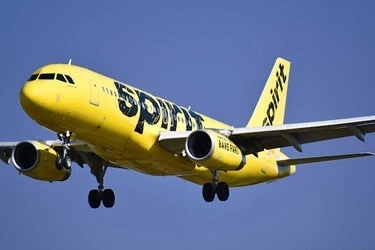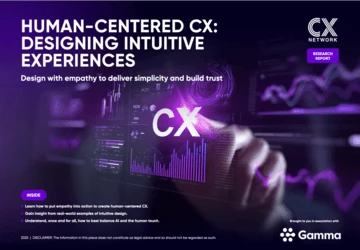Spirit Airlines adopts AI-powered self-service
Learn about how travel disruptions led to the airline executing solutions that leverage AI and make self-service possible
Add bookmark
Spirit Airlines' decision to adopt artificial intelligence (AI)-powered self-service, in the wake of the travel disruptions caused by the Covid-19 pandemic, is paying off. After experiencing tremendous contact volume spikes, which sometimes required double their normal staffing levels, Spirit Airlines leaders realized manual resolution was not enough. Customers suffered through long wait times and a lack of control over their travel itineraries, and they let the airline know they were upset.
"It was unsustainable," said Vanessa Hardy-Bowen, director of guest care and contact centers at Spirit Airlines when she recently shared this story with audience members at CX Network's All Access: AI + Data in CX 2025 webinar series.

Don't miss any news, updates or insider tips from CX Network by getting them delivered to your inbox. Sign up to our newsletter and join our community of experts.
Turning toward AI-powered self-service
Hardy-Bowen explained the focus was quickly placed on empowering guests to resolve their own issues as much as possible. The airline soon had a complete to-do list:
- Identify repetitive, high-volume questions or concerns.
- Analyze the reasons for guest calls.
- Create proactive workflows to anticipate guest needs.
- Capture guest intent more accurately.
- Implement application interface programming (API) software and frequently asked questions (FAQs) to enable self-service.
- Quickly route complex issues to human agents.
"We wanted to flip our approach from being reactive to proactive, anticipating what might potentially happen and putting ourselves in the position to capture guest intent more accurately at the top of the digital or voice experience," said Hardy-Bowen.
To begin, the airline sought to identify low-hanging fruit for AI applications. Mainly, Hardy-Bowen and her colleagues looked for repetitive issues that could be resolved without human empathy.
"We needed processes that just required speed, clarity and accuracy," she said. "We focused on areas like flight credits, rebooking guidance and FAQs that could be automated. We then defined our success by containment rates - how many guests' [issues] we could resolve without escalation - and by tracking guest satisfaction scores to ensure we were alleviating pain points."
Watch the full session on demand here.
Should you buy or build AI solutions?
Like many organizations today, Spirit Airlines confronted the question of whether to buy a vendor solution or build their own internally.
"It's definitely a dance, and sometimes I'm not the best dancer," said Hardy-Bowen. "It takes a lot of communication and humility. We always have an internal vision of what needs to be fixed, but we don't always have the speed or technical capability to support that. My role often becomes like a traffic cop, aligning priorities, setting expectations and making sure we stay focused on outcomes, not just features."
Ultimately, the team took a hybrid approach. Spirit Airlines uses a combination of internal development and external vendors for their AI solutions. While the internal team has a vision for the guest experience, they sometimes rely on vendors for their speed and technical capabilities. However, close collaboration is required to ensure the solution fits Spirit’s brand and regulatory needs.
Throughout the process, the team turned to proof of concept (POC) pilots to test use cases. This was an important part of the project because it kept people focused and continuously aiming for a positive return on investment (ROI).
"It was really about validating the business case and showing scalability," said Hardy-Bowen. "We had to stay focused on our use case, set clear metrics for success and ensure every stakeholder was involved from the very beginning. The most critical part was not throwing a finished product over the fence, but earning trust along the way and making the POC a sandbox where teams could test and scale smartly."
So far, the results have been positive. Spirit Airlines’ CSAT (customer satisfaction) scores are now in the high 80s and sometimes in the high 90s for both digital and voice environments. Hardy-Bowen reported improvements in containment rates and reduced agent handle time.
The feelings of human agents
However, whenever AI becomes part of CX, human agents have questions and concerns. These transformative projects, in fact, require a change management strategy. It was no different for Spirit Airlines.
"It's not about replacing jobs," said Hardy-Bowen. "It's about enhancing efficiency. We were intentional about transparency, involving frontline staff from the very onset and providing avenues for feedback and questions. We saw our agents adapt to new tools, which not only helped improve morale but also validated our path of incorporating AI to support their work."
As a result of Spirit Airlines' journey with AI-powered self-service, Hardy Bowen advised others to start small.
"Pick something meaningful that can show results. Don't try to solve everything on the first day," she said. "Find high-volume, rule-driven processes with measurable impacts. Engage internal partners early, so they become enablers, not blockers. And always connect your AI strategy to both guest experience and cost goals."
With AI continually advancing at warp speed, Hardy-Bowen anticipates improving employee engagement and CX even more. In other words, this is only the beginning of the airlines' journey with AI.
"We want to move from a transactional AI environment to a relational experience," said Hardy-Bowen. "This means anticipating not just what guests need, but personalizing suggestions based on who they are. On the agent side, we see huge opportunities for real-time coaching, pulling up insights and helping agents get to resolution quicker while elevating the human side of interactions."
Quick links:
- Verizon bets on AI agents to transform CX
- Preparing your data for AI in CX: Ethics, centralization and adoption
- Walmart Mexico's customer insights revolution with AI















